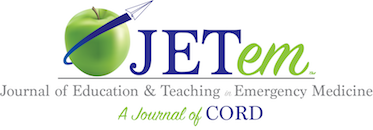The EMazing Race: A Novel Gamified Board and Clinical Practice Review for Emergency Medicine Residents
ABSTRACT:
Audience:
Emergency medicine residents and medical students
Introduction:
Many emergency medicine residency programs have their residents take an in-training exam (ITE) in which performance has been linked to certifying exam pass rates, so solid preparation is important.1 The typical clinical schedule of an emergency medicine resident is incredibly varied and time-consuming, which limits time to dedicate to preparation. All emergency medicine programs have synchronous and asynchronous protected time for resident education which provides an excellent opportunity to prepare learners for in-training exams and thus the certifying exam. Gamification is a promising tool some educators have turned to which has been shown to improve attitudes and behaviors towards learning.2 This may make it a useful tool for board-review, particularly for the cohort of residents who may have negative attitudes or behaviors towards preparing for it.3 This session took inspiration from “The Amazing Race” — a reality television competition where teams race around the world — to provide learners with an exciting activity during dedicated synchronous or asynchronous educational conference time, which may be helpful for board review. Residents may prefer question-based preparation for the in-training exam, so the authors devised The EMazing Race to include some components of this while also adding more clinical practice-relevant topics and activities.3
Educational Objectives:
By the end of this 2-hour session, learners will demonstrate their knowledge on the following board-related emergency medicine topics:
Ob/GYN – links to 13.7 Complications of Delivery in Core Model of EM 2022
- Know the first maneuver to manage a nuchal knot in an emergency delivery
- Recognize the signs of shoulder dystocia and learn multiple maneuvers to manage this including McRoberts, suprapubic pressure, Rubin, Woods, and Menticoglou
- Identify the steps in delivering a fetus in breech positioning and learn about the Gaskin maneuver
- Understand management of trauma in pregnant patients including maneuvers to manage hypotension, recognition of uterine rupture, placental abruption, as well as rupture of membranes and its diagnostic findings
Renal/GU – links to 15.0 Renal and Urogenital Disorders in Core Model of EM 2022
- Review indications for admission in patients with nephrolithiasis such as intractable nausea and vomiting
- Recognize signs of acute tubular necrosis by urinalysis findings
- Recall that staghorn calculi are most commonly composed of magnesium, ammonium, and phosphate
- Identify appropriate medications to manage hypertension in patients with kidney disease
- Recall various managements of priapism including intracavernosal irrigation, drainage, and phenylephrine injection
- List specific indications for emergent hemodialysis including specific medications
- Identify appropriate medications to manage various GU infections including balanitis and acute cystitis in men and women of varying ages
- Identify the most common presenting sign of a nephroblastoma
Splinting – links to 18.1.8.2 Extremity bony trauma, fracture in Core Model of EM 2022
- Demonstrate the proper application of the following splinting techniques: thumb spica, sugar tong, and posterior leg splint
Educational Methods:
Inspired by the reality TV show competition, “The Amazing Race,” small groups of residents and medical students from all years of training raced through a series of stations separated geographically with distinct educational objectives, guided by clues won after completion of each leg or “task.”
Research Methods:
Following completion of the race, participants were provided with a voluntary survey asking them to indicate for the following statements whether they strongly disagree, disagree, are neutral, agree, or strongly agree: (1) The activity was engaging. (2) I prefer this type of learning to traditional lecturing. (3) I found this activity helpful for board/ITE review. (4) I learned something new about Ob/GYN, renal, and/or splinting. (5) Open response: What other feedback do you have? Optional pre- and post-intervention ROSH review questions on OBGYN were administered one month before and one month after the intervention.
Results:
Twenty-five out of 28 individuals responded to the survey. All but two individuals stated they “strongly agree” that the activity was engaging. All but one respondent “agree” or “strongly agree” that they prefer this type of learning to traditional lecturing. Sixteen respondents stated “Strongly agree” and four stated “agree” that they found this activity helpful for board/ITE review. Eighteen respondents stated “strongly agree” and seven others stated “agree” that they learned something new about Ob/GYN, renal, and/or splinting. Open-response feedback was overwhelmingly positive and commented on a desire for future similar outdoor educational activities and its benefit as a team-building exercise. The majority of learners (four out of seven) who completed the optional pre- and post- ROSH review questions set on OBGYN content had an increase in their ROSH review score.
Discussion:
Gamification has been shown to be a promising tool for improving attitudes and behaviors towards learning, which aligns well with our learner feedback.1 Learner feedback was extremely positive, primarily centered around a desire for similar activities in the future. Most learners found the session engaging, preferable to traditional lecturing, and helpful for ITE/board preparation which suggests that the format could be used as an alternative way to review board material. Some studies have shown benefits to outdoor learning, though this has not been examined in emergency medicine didactics specifically.4 In the future, the authors intend to employ more gamification in resident education and will trial increased use of outdoor spaces in these activities, given learner preference for this.
Topics:
Breech delivery, shoulder dystocia, emergent dialysis, acute kidney injury, trauma in pregnant patients, genitourinary tumors, acute cystitis, nephrolithiasis, balanitis, thumb spica, sugar tong, posterior short leg, splinting, small-group activity, team-building exercise, educational games, gamification, outdoor activities, race.
